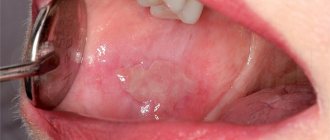One of the most common childhood diseases is stomatitis: according to statistics, more than 80% of parents experience it.
This is not as harmless a disease as it may seem, because if the disease is ignored and left untreated, the infection can lead to complications that will require much more time and effort to combat. Therefore, it is extremely important to know what childhood stomatitis looks like, as well as how to treat it.
Causes of stomatitis in a child
In childhood stomatitis, the mucous membrane of the oral cavity is affected: small pimples of white or yellowish color, filled with liquid, appear on its surface. In some cases, ulcers form.
Stomatitis is predominantly a childhood disease, although it can also occur in adults. The rash affects the inner surface of the cheeks, tongue and gums. The disease causes a lot of inconvenience: pimples hurt and itch, their appearance is accompanied by a burning sensation in the mouth.
Among the main reasons for the development of stomatitis are:
- poor oral hygiene;
- injury to the mucous membrane;
- diseases of the gastrointestinal tract;
- oral burn;
- pathogenic bacteria that enter the oral cavity from dirty hands, toys, etc.
Causes
The pathology is caused by numerous infectious agents, as well as oral injuries and allergic reactions. The reason for its development may be a lack of certain vitamins and microelements.
The following types are distinguished:
- viral (herpetic - present in 80% of all cases, the rest are represented by measles, chickenpox, influenza, rubella, mononucleosis, adenovirus, enterovirus, papillomavirus viruses);
- fungal – candidiasis is detected in the vast majority of cases in infants; in older children it occurs due to immunodeficiency, diabetes, or taking antibiotics;
- bacterial - most often it is caused by various types of staphylococci and streptococci; in rare cases, stomatitis is caused by pathogens of tuberculosis, syphilis, diphtheria, gonorrhea;
- allergic – often the pathology develops as a reaction to various products, components of toothpaste, chewing gum;
- autoimmune – in the occurrence of aphthous lesions, one of the leading causes is considered to be the presence of autoimmune problems;
- traumatic - in children, the oral mucosa is less stable than in adults; it is easily damaged under the influence of chemical and physical agents, or mechanical trauma.
The factor that caused this pathology determines the treatment tactics and what drugs will be prescribed.
There are factors that contribute to the development of the disease.
These include:
- diseases of the gastrointestinal tract (duodenitis, gastritis, intestinal dysbiosis, colitis, enteritis);
- blood diseases;
- pathologies of the nervous and endocrine systems;
- helminthiases;
- prematurity;
- insufficient oral hygiene;
- weak local immunity;
- lack of microelements, vitamins (B vitamins, selenium, zinc).
All these numerous factors cause and contribute to the development of stomatitis. In this regard, there is a significant difference in the treatment of different types of disease.
Symptoms of the disease
Before treatment can begin, the disease must be recognized. Stomatitis has a number of symptoms, thanks to which the disease cannot be confused with any other. These include:
- the appearance of swelling of the mucous membrane;
- formation of yellow or white plaque on the mucous membrane;
- enlarged lymph nodes, accompanied by an increase in body temperature;
- constant formation of saliva in large quantities (sometimes, on the contrary, stomatitis is accompanied by increased dryness);
- bad breath.
The photo gives a clear understanding of what stomatitis looks like.
These are general symptoms, but they may have their own characteristics depending on the type of disease:
- allergic stomatitis is accompanied by the formation of ulcers on the palate, tongue, inner cheeks, and gums;
- aphthous stomatitis is characterized by the formation of larger yellow spots, up to 1 cm in diameter, with inflamed edges;
- Herpetic stomatitis can be distinguished by the abundance of small fluid-filled rashes that combine into one large wound. In addition, herpes can cause a general deterioration in health - high fever, weakness and body aches;
- with candidal stomatitis, a white coating appears on the inner surface of the cheeks and tongue. The cause of candidiasis is poor hygiene or a consequence of antibacterial therapy.
Regardless of what kind of stomatitis the child has, treatment should be prescribed immediately after the first signs of the disease are detected: delay is fraught with aggravation of the situation, which will lead to an increase in healing time. How to treat stomatitis in children in the mouth will depend on the form of the disease and the reasons for its development: treatment methods in each case will be unique.
Types of aft.
Small aphthae is the most common type of aphthae (80-85%). Their size ranges from 1 to 10 mm. Ulcers can appear singly or several at a time (up to five).
Usually heal in 7-10 days.
Large aphthae (10-15%) - more than 10 mm in diameter, can even be up to 3 cm, deeper, take longer to heal (10-30 days).
They may leave scars behind. Very rare in children.
Herpetiform aphthae (5-10%) are small, from 1 to 3 mm, located in groups like herpetic vesicles. They heal quickly, within 10 days. They are not typical for children; they usually occur in the elderly.
The rest of the oral cavity looks normal - there is no inflammation of the gums, redness of the tonsils and pharynx, enlarged and painful cervical lymph nodes.
There is no fever or other general manifestations.
Aphthae in children is manifested primarily by refusal to eat and drink due to pain in the mouth.
The reasons for the recurrence of aphthae are not completely clear; the most popular theory is related to errors in the immune system.
Doctors most often do not find a specific cause of the failure; most likely it is a combination of several factors.
But doctors still have assumptions about some factors.
How to treat childhood stomatitis
Once the diagnosis has been made, treatment for stomatitis should begin as soon as possible. It is necessary to keep in mind that prescribing medications yourself: the decision can only be made by a pediatrician who has information about how this or that medicine can further affect the well-being of a small patient. First of all, the doctor must prescribe a scraping to determine the type of causative agent of the disease, and a virological study: depending on this, the type of treatment is prescribed.
The duration of treatment is influenced by the advanced stage of the disease and the type of stomatitis: on average, it is possible to overcome the disease within a week, provided that the doctor’s recommendations are fully followed.
Children's stomatitis: treatment with medications
Doctors prescribe symptomatic medications, the purpose of which is to get rid of the symptoms that accompany the development of the disease.
Appointed:
- vitamin complexes to strengthen the child’s immunity as a whole;
- antiviral drugs;
- antipyretic drugs;
- gels and ointments for treating the oral cavity.
In addition, it is recommended to drink plenty of fluids and eat a diet that excludes the consumption of spicy, sour and highly salty foods.
The most commonly prescribed drugs for stomatitis are:
- Miramistin. An antifungal solution that prevents wound infection. The drug starts the process of regeneration of damaged tissues.
- Vinilin is an anesthetic with a healing effect. The medicine forms a protective film on the surface of the ulcers, protecting them from irritation when eating food, as a result of which the healing process is accelerated.
- Nystatin is an effective treatment for candidal stomatitis.
- Metrogyl Denta is an antibacterial drug applied twice a day to damaged areas of the mucous membrane.
- Acyclovir is an antiviral drug that prevents new lesions of the rash from appearing. The drug is applied up to 6 times during the day. Thanks to its use, the formation of crusts is accelerated.
Children's stomatitis: treatment with folk remedies
Many parents, in addition to or even instead of medications, prefer to use traditional medicine. As mentioned above, you should not do this without the consent of your doctor, however, you cannot fail to mention these methods of treatment.
So, among these funds it is worth highlighting:
- soda-salt solution. An equal amount of soda and salt are dissolved in a glass of water (about half a teaspoon of each component). It is recommended to rinse your mouth with the resulting solution 4 times a day after meals;
- infusion of chamomile with honey. For the solution, take a glass of boiling water and a tablespoon of chamomile. When the liquid cools, add 2 teaspoons of honey. The product is used for rinsing 3 times a day;
- brilliant green is the most affordable remedy available for sale in any pharmacy. It dries out wounds and prevents new foci of disease from forming.
Mouth treatment
The most effective measures for treating the disease are rinsing with physiological antiseptics and irrigating the oral cavity with anti-inflammatory sprays.
For treatment of the oral cavity they are used;
- miramistin solution;
- 0.06% chlorhexidine solution;
- 0.02% solution of furatsilin;
- 0.1% dimexide solution.
During therapy, it is important to select medications that provide a quick cure.
The following medications are used for therapy:
- application of anesthetics with proteolytic enzymes for 10-15 minutes once a day (trypsin, lysozyme, ribonuclease);
- applying epithelializing ointments to ulcers (Solcoseryl-gel);
- rinses with antibacterial drugs: Tantum-Verde in a dosage of 15 ml 3-4 times a day, 5-6 days or use Hexoral, Orasept;
- applications of Mundizal gel to the oral mucosa for 20 minutes 3-4 times a day, 5-10 days;
- balm Stomatofit-A, it contains painkillers, extracts of medicinal plants;
- antifungal drugs;
- painkillers, anti-inflammatory ointments (Benzocaine, Xicaine);
- Diphenhydramine suspension to relieve allergic symptoms.
Herpetic stomatitis in children
There are several types:
- sharp;
- chronic.
This type of damage to the oral mucosa occurs when the herpes virus first enters the human body. Acute stomatitis is typical only for young children. Herpetic stomatitis that occurs repeatedly is called chronic. Herpes stomatitis in an infant appears due to infection of the child by the mother or other people who kiss the baby out of excess of feelings or taste food with the spoon with which he is then fed.
Acute herpes-type stomatitis
The herpes virus enters the baby's body after he reaches the age of six months. At this time, the antibodies the child received from the mother gradually cease to act. In the vast majority of cases (about 90%), the symptoms of stomatitis at such an early age are mild, and only in 10% of children the disease is acute.
Stomatitis in children under one year of age, the treatment of which takes about 2 weeks, is accompanied by weakness in the body, general malaise and muscle pain, which is explained by poisoning of the body. In some cases, the temperature during the first two days of the disease may rise to 40 degrees or higher. The lymph nodes become inflamed, and touching them causes pain to the baby.
A distinctive sign of the disease are small bubbles that appear in groups on the lips, palate, and tongue. The oral mucosa takes on a bright red hue. The bubbles are filled with a clear liquid that gradually becomes cloudy. After about 3 days, the blisters burst, leaving behind erosions covered with a yellow or white fibrinous coating.
Sometimes the gums near the teeth may turn red, so the disease is often confused with gingivitis.
Chronic stomatitis
Once the herpes virus enters the human body, it remains there forever. Symptoms may occur when:
- cold;
- lack of vitamins;
- stressful situations;
- exacerbation of sinusitis, tonsillitis and other chronic diseases;
- injury to the mucous membrane;
- gingivitis or caries;
- habit of breathing through the mouth (lips become dry, causing the skin in the corners of the mouth to crack).
Chronic stomatitis develops in exactly the same way as acute stomatitis, with the exception that the disease does not affect the general condition of the body, because intoxication is minimal.
Herpetic stomatitis in children: how to treat
Types of treatment:
- Use of antiviral agents. Ointments and gels, which are often used to treat herpes on the lip, should not be applied to the oral mucosa. Treatment is possible with suppositories or tablets. The most effective drugs include two drugs. The first of them is “Viferon”, which contains interferons that have an immunostimulating effect. Available in the form of suppositories and gel. There are no age restrictions on the use of the product. The gel should be applied directly to the affected mucous membrane, after drying it with a swab. The treatment period does not exceed one week, provided that the product is regularly applied three times a day. The second is the antiviral drug Acyclovir, which acts on the herpes virus itself, and does not simply increase immunity. The dosage regimen is the same for children over 2 years of age and twice.
- Rinse. It is necessary to use solutions whose action is aimed specifically at suppressing the herpes virus (such popular and cheap remedies as chlorhexidine and various herbal infusions are not suitable). The most effective drug is Miramistin, which should be rinsed three times a day. For greater results, you can apply Viferon a short period of time after rinsing.
- Use of symptomatic remedies. Antipyretic drugs are used when body temperature exceeds 38 degrees. At lower temperatures, such tablets will do more harm, since they will interfere with the formation of natural immunity and the production of interferons.
- Use of immunomodulators. If stomatitis in children, which was treated according to all the rules, makes itself felt again, you can resort to the use of immunomodulators, the most effective of which are:
- “Immunal” is a basic drug that increases immunity.
- “Imudon” stimulates the immunity of the oral mucosa. One course lasts 20 days (you need to take 6 tablets every day). 2 courses per year are recommended.
- Toothpastes with lactoferrin and lysozyme (these substances are contained in special Splat children's toothpastes).
Folk remedies
Folk remedies are usually used during follow-up treatment, when acute manifestations are eliminated.
For the treatment of stomatitis the following is used:
- infusion of chamomile flowers;
- paste from ground burdock seeds with salt and butter;
- decoction of oak bark;
- aloe juice;
- a decoction of the rhizome of snakeweed;
- yarrow decoction;
- infusion of ground rhizome of bergenia;
- infusion of pomegranate peel.
Physiotherapeutic agents include treatment of lesions with ultraviolet rays.
Aphthous stomatitis in children
Manifests itself in the form of small individual ulcers on the lips and oral mucosa. Its appearance is provoked by:
- allergic reactions of various types (to food, medications, etc.);
- staphylococci (there are many of these bacteria in carious formations and dental plaque);
- immunity disorders;
- liver diseases.
Aphthous stomatitis in children: symptoms and treatment
Exacerbation occurs mainly in autumn and spring. Ulcerations most often form on the lips, tongue and inside the cheeks (in these places the mucous membrane comes into contact with food and can be injured by the teeth).
Sometimes weakness in the body and fever appear, but often the general condition of the body remains normal.
The size of the ulcers (ulcers) is 5-10 mm. They are covered with a grayish coating and are surrounded by a red, inflamed rim of mucous membrane. There is pain when touching them. It happens that only 1 ulcer forms.
Aphthous stomatitis in children: treatment
The causes of stomatitis in children will influence the nature of treatment. Immediately after the first symptoms appear, it is necessary to adjust the child’s menu, completely eliminating the main allergens (chocolate, honey, berries, citrus fruits, etc.). During illness, you should also not eat spicy foods with added spices.
Often, aphthous stomatitis becomes a reaction of the body to medications, so if a child is taking medications, it would be a good idea to consult a doctor.
Treatment methods:
- Antiallergic drugs. The most frequently prescribed are Suprastin, Diazolin and many others like them.
- Treatment of ulcerations. At the initial stage of the disease, “Miramistin” (they are recommended to spray the aphras using a special sprayer that comes with the drug) and “Cholisal” (ulcers are treated with gel at least 3 times a day) perform well. When the acute symptoms of the disease pass, you can use Solcoseryl, a gel that accelerates the healing of mucosal defects and has an analgesic effect.
- Exposure to UV rays in a physiotherapy room.
- Use of immunomodulators. Firstly, it is worth purchasing a special toothpaste based on lactoferrin, and secondly, you can take a course of Imudon.
- Sanitation of the oral cavity. Since one of the causes of stomatitis is microorganisms, all carious formations must be cured and plaque removed.
Diagnostics
Aphthous stomatitis is a dental disease, so the right decision would be to seek help from a dentist. For quality treatment, diagnostics are required.
The main method of collecting anamnesis is interviewing the child and parents about complaints, as well as examining the oral cavity. Considering how many features the disease can have, only a qualified and experienced specialist should treat a small patient.
After determining the clinical picture, possible causes and the presence of provoking factors, the doctor can draw up a treatment regimen.
Preventive measures to prevent stomatitis in children
To minimize the risk of developing stomatitis you need to:
- wash the child’s toys, bottles and other things regularly, and do not forget to thoroughly wash the baby’s hands;
- strengthen the child’s immunity;
- do not let your child bite his nails;
- create a balanced menu containing all the necessary minerals and vitamins. The diet should be followed;
- promptly treat diseases such as tonsillitis, gastritis and other gastrointestinal diseases. If you extinguish the outbreak in time, this will prevent stomatitis from developing;
- At least once a year, and preferably twice, visit the dentist for a detailed examination of the oral cavity.
All these simple recommendations will help avoid the occurrence of stomatitis, because any disease is much easier and cheaper to prevent than to treat it later. If it was not possible to avoid the disease, at the first signs of it, you must consult a doctor to prescribe effective treatment. If stomatitis appears again and again, a thorough immunological examination is required. The child should be examined by a pediatrician and an immunologist; it is also advisable to contact an endocrinologist and gastroenterologist (perhaps they will identify a chronic disease leading to relapse of the disease).
It is equally important to teach your child proper oral hygiene. If the teeth are affected by caries and covered with plaque, and there are fistulas on the gums, the fight against stomatitis will not be successful. A child must be taught how to properly brush his teeth and gums by buying him a brush and toothpaste appropriate for his age.
What can help in finding the cause of aphthae?
A conversation sometimes helps to find out whether relatives have important diseases with a family predisposition - celiac disease, Crohn's disease, lupus erythematosus.
During the examination, the doctor can evaluate the general manifestations of the disease (not typical with ordinary recurrent aphthous stomatitis) and check for the presence of ulcers outside the oral cavity.
The simplest laboratory examination is carried out - this is most often enough.
A general blood test may show anemia due to deficiency of iron, folic acid, and vitamin B12.
The level of neutrophils is also assessed - their decrease may be a sign of the rare systemic disease cyclic neutropenia
A high ESR may be a sign of Crohn's disease and ulcerative colitis.
Serum iron levels may be reduced in up to 20% of recurrent canker sores.









